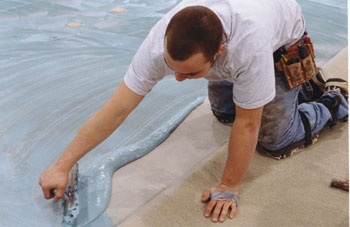
"I had over an acre of concrete that I needed finished with VCT tile or glassback carpeting," said Schueller. "Problem was that the flooring contractor wouldn't guarantee the adhesion of the floor coverings if the concrete wasn't dry. On top of that, the customer wanted to shorten the construction schedule by a week! When I started looking for a solution, I knew that conventional methods would take too long."
Schueller was responsible for completing a giant Best Buy retail electronics store in Portland in just four weeks. After the building was closed in, sheet rocking, painting and flooring were scheduled to go quickly, but high interior humidity and moisture trapped in concrete floor and masonry walls were proving a difficult problem.
Concrete is evaluated for moisture content using a calcium chloride test. Calcium Chloride, a highly hygroscopic salt, is exposed to the new concrete under a small plastic dome that is sealed to the floor. The amount of water it absorbs in a specific time is measured to determine how dry the concrete has become. The readings are expressed in lbs/1000 sq. ft./ 24 hrs. This is a measure of vapor transmission.

Fortunately, when Schueller started researching a solution, an associate, Mike Price, S. D. Deacon's operations manager had used Munters, a company that specializes in drying at construction sites.
"We have been providing construction drying services for over 30 years," said David Carlson, an industrial account manager with Munters Moisture Control Services, who works out of its Portland office. "But mostly in Europe where integrating drying with construction activities is common place. In the United States, construction drying is 'new' idea that is coming into fashion with increased pressure to finish projects on time or ahead of schedule."

"Munters dehumidifiers are used to protect the Space Shuttle before launch," said Carlson. "More than 10,000 manufacturing sites control their process environments with a Munters dehumidifier. We use them to dry out buildings after floods. They keep mothballed battleships from rusting. Desiccant dehumidification is an amazing technology that is used throughout American industry."
At Best Buy, Munters installed three of its high volume construction site dehumidifiers outside the building and strategically distributed dry air throughout the interior, using a network of flexible ducting.
"I'd never heard of drying concrete," said Joe Schueller, "but I told Munters if they could do what they said, they'd better get right to it because my deadline had our backs to the wall." "I don't think Joe thought desiccant drying would work," said Carlson. "Dry air is invisible and many of our customers at first have a healthy skepticism ... but the proof is in the results."
In three weeks, Munters had dried down the concrete slab to 4.4 lbs/1000 sq. ft./per 24 hours and was gone from the site. Not only had the floor reached a safe moisture content for tile and carpet to be adhered, but several unexpected advantages emerged as bi-products of the drying process.
"The building needed the masonry block walls sealed and painted"" said Carlson. "The wall had soaked up water during rainstorms which occurred before the roof was completed. Discoloration indicated moisture in the block walls. With February weather outside and high humidity from the floor inside, there was no way that wall could dry on its own. But as we dried the floor, the wall also dried."

"One thing you can't do in the construction business is miss the deadline," said Schueller. "We didn't at Best Buy thanks to Munters. If I were in a similar situation, you can bet I'd call Munters back again."
Publication date: 02/19/2001

Report Abusive Comment